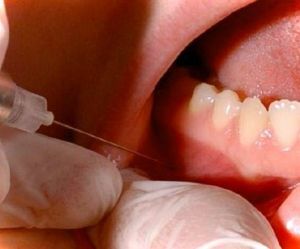 Thanks to the wide introduction of adequate, painless and easy-to-use methods of anesthesia and modern drugs for qualitative anesthesia, the patient of a modern dental office has ceased to experience discomfort and pain during dental treatment.
Thanks to the wide introduction of adequate, painless and easy-to-use methods of anesthesia and modern drugs for qualitative anesthesia, the patient of a modern dental office has ceased to experience discomfort and pain during dental treatment.
Local anesthesia plays a major role in performing dental manipulations in the oral cavity and is used in practice much more often than general anesthesia.
Contents
- Torus analgesia
- Anatomical implication
- Cases suitable for use with this technique
- Variety of technique
- Method Akinosi
- Pros and cons
- Gates Gates anesthesia
- Advantages and disadvantages
- Other, less popular methods
- Possible needle insertion errors
Torus analgesia
Torus anesthesia is a form of local anesthesia in which the anesthetic is injected into the mandibular shaft- torus. During the injection, the needle is in one position, which greatly facilitates the development of technology. Opened this method of anesthesia in 1941 by M. M. Weisbrem.
When the anesthetic is injected, the sensitivity threshold is lowered:
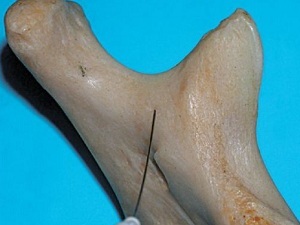
The mandibular shaft looks like the
- of the mandibular;
- of the chin area;
- of the alveolar process;
- of the facial skin;
- oral mucosa.
Weisbrum's thoracic anesthesia differs from the standard mandibular anesthesia in that the needle is at the same angle throughout the entire injection.
Anatomical implication
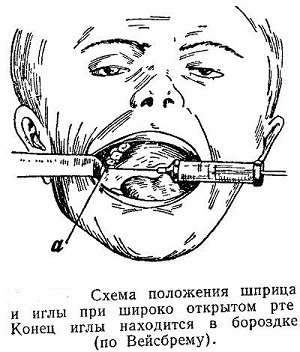 After the anesthetic is injected into the mandible, the preparation immediately begins to affect the lower lacrimal, buccal and linguistic nerve endings.
After the anesthetic is injected into the mandible, the preparation immediately begins to affect the lower lacrimal, buccal and linguistic nerve endings.
The mandibular cusp is formed from 2 bone cords of the muscular and coronoid processes, they are located higher and anterior to the ossicle, along the slopes of this formation and there are 3 nerve endings that lose sensitivity.
Due to this effect, the sensitivity in the area from the 2nd premolar to the 2nd molar in the middle is switched off, which makes it possible to perform dental manipulations on the dental line painlessly and to operate the problem areas of the oral cavity.
Cases Suitable for Use of This Technique
The application of Weisbrem anesthesia is possible for:
- for the dissection of abscesses, boils, phlegmon and other purulent formations within the mouth;

- performing operations in the area of the dentition of the lower jaw;
- removal of abnormally located teeth;
- removal of wisdom teeth;
- depulpation;
- overlapping tires for fractures of the lower jaw;
- operating cysts, tumors and mutilated bone sites in the mandibular section.
Varieties of
technique Torus anesthesia is performed using several techniques:
- by Go-Gates;
- for Aquinosi-Visari;
- for Legardi - palpatory way.
Anesthetic can also be administered:
- using the apodactyl technique;
- extraoral way.
Method Akinosi
This technique is exclusive for dental practice, during handling, the needle is completely excluded from contact with the bone tissue and it is acceptable when the mouth is opened weakly.
The manipulation involves the introduction of the drug into the retro-part - the border of the mucous cheek with compressed grin, in order to achieve an anesthetic substance, the head of the appendix of the lower jaw joint.
The technique of medication administration requires that the patient's mouth be closed. The sting of the needle, 35 mm in length, is inserted into the space between the mandibular junction and the mandibular thigh, so that the instrument, which has reached the wing-jaw area, contacts the nerve taps in the area. Anesthetic in the volume of 1.5 - 2 ml should be entered without haste.
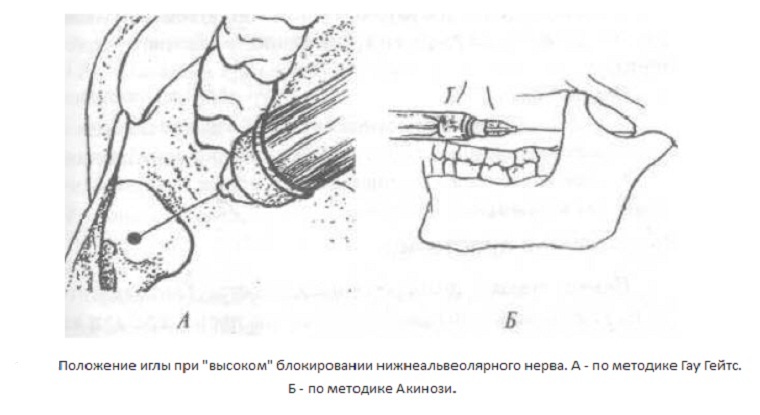
With the use of the variant of anesthesia according to Akinosia, sensitivity is lost:
- lunochkovke nerve;
- lingual nerve.
This method should be used in exceptional cases when there is no expected effect from the use of other methods of anesthesia, as it has a number of complications:
- trisus, as a reaction to temporal muscle damage;
- when the needle deviates from the specified trajectory, trism is possible due to damage to the lateral or medial pterygoid muscle;
- periosteal injury;
- damage the facial nerve with a deep introduction of the needle into the salivary gland near the ear.
Pros and Cons of
The drawback of this technique lies in the large number of complications and complexity of the procedure - this method of anesthesia is used only by experienced dentists.
The plus is that the method of Aquinosi-Wizari is the best auxiliary method of anesthesia, if there are more than three standard nerves in the tooth.
Gates Gates anesthesia
The method was developed in 1973 by the Australian dentist Go-Gates. The technique of implementation is quite complicated, but at the same time it has clear guidelines and is effective in 97% of cases.
The peculiarity of the method lies in the change in the mutual location of the destination for the anesthetic and the mandibular nerve with sufficient opening of the mouth.
In the process of unfolding, the mandibular rotation is performed around the front axis in the same tier of the joint, so that the head of the condylar process extends through the cartilaginous disc forward to the joint elevation.
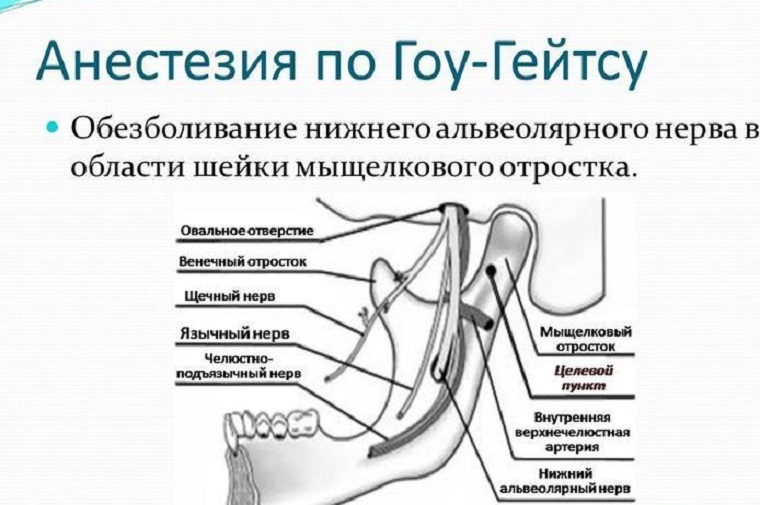
Technique of carrying out thoracic anesthesia according to Go-Gates( visual video in two parts below):
- after all the preparatory procedures - choosing the right location of the patient and dentist, handling the site of the future injection, - the patient is asked to open the mouth as much as possible;
- the doctor at this time has a syringe in the corner of the lip, with his thumb pulls back the cheek, and the forefinger, located opposite the ear tragus, controls the degree of opening of the mouth;
- the needle is inserted into the pterygo-jaw space and the medial tendon of the temporal muscle, to the area of the application before it;
- then pierce the mucous membrane and slowly move the needle until it stops in the bone, then push it back over 1 mm and make an aspiration test;
- after a negative test result, slowly inject 1 capsule of the substance, during the manipulation of the patient is vigilant control;
- after all the stages of the process, the instrument is removed, and the patient is asked not to close his mouth for a couple of minutes before the full action of the anesthetic.
In this case, the sensitivity is removed from the following nerves:
- of the lower lunar;
- reed;
- of the jaw-hyoid;
- of an ear-temporal;
- Genus.
Of complications occasionally, it is possible to develop a hematoma at the injection site and difficulty breathing.
Advantages and disadvantages of
Positive aspects of the technique for carrying out thoracic anesthesia according to Go-Gates:
- high efficiency percentage from 90 to 97%;
- clear definition of landmarks;
- insignificant degree of complications.
Disadvantage - a long period of effect, 2 to 5 minutes longer than using other options.
Other, not so popular methods
Among other techniques, the following are sometimes used: 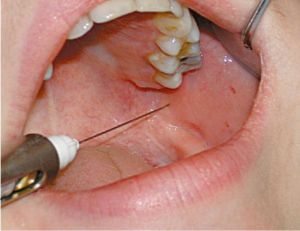
- According to Legarti, is used for both insufficient and open mouth opening, the needle stitch is inserted at the anterior margin of the lower jaw, it moves along its inner edge and an anesthetic is gradually released. During manipulation, the upper section of the retro-molar triangle is palpable.
- The adaptive version of - a reference point in this variant is the pterygo-mandibular fold, which can be of various widths and is located to the inner part of the oral cavity from the temporal scallop.
- Extraoral access is used when there is no access inside the mouth, in the course of its application the projection of the mandibular slit on the skin is specified. The anesthetic is injected in two doses.
Possible errors when inserting the needle
If the needle and( or) medicine is incorrectly inserted, many complications may develop:
- loss of sensitivity of the mucosa;
- internal pterygoid muscle damage with further development of the mandibular contracture;
- vascular disruption, which leads to hemorrhage;
- penetration of the drug into the blood, which causes ischemia of the skin of the chin and lower lip;
- paresis of muscles responsible for facial expressions;
- development of neurotic states;
- fracture of the needle, which can not be immediately removed if it is left deep in the tissues - this operation must be performed in a stationary manner after X-rays;
- post-injection inflammatory processes.
Any kind of anesthesia has a negative effect on the liver, destroying its cells, but this is not a reason to give up an anesthetic, it is enough to use innovative means after anesthesia, which are designed to support the body in such situations.
